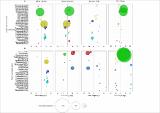Por favor, use este identificador para citar o enlazar a este item:
http://hdl.handle.net/10261/227148COMPARTIR / EXPORTAR:
 SHARE SHARE
 CORE
BASE CORE
BASE
|
|
| Visualizar otros formatos: MARC | Dublin Core | RDF | ORE | MODS | METS | DIDL | DATACITE | |

| Título: | Functional Seasonality of Free-Living and Particle-Associated Prokaryotic Communities in the Coastal Adriatic Sea |
Autor: | Steiner, Paul; Geijo, Javier; Fadeev, Eduard; Obiol, Aleix CSIC ORCID ; Sintes, Eva; Rattei, Thomas; Herndl, Gerhard J. | Palabras clave: | Coastal Mediterranean Sea Seasonal dynamics Eukaryotes Adriatic Sea Prokaryoplankton Marine snow particles |
Fecha de publicación: | nov-2020 | Editor: | Frontiers Media | Citación: | Frontiers in Microbiology 11: 584222 (2020) | Resumen: | Marine snow is an important habitat for microbes, characterized by chemical and physical properties contrasting those of the ambient water. The higher nutrient concentrations in marine snow lead to compositional differences between the ambient water and the marine snow-associated prokaryotic community. Whether these compositional differences vary due to seasonal environmental changes, however, remains unclear. Thus, we investigated the seasonal patterns of the free-living and marine snow-associated microbial community composition and their functional potential in the northern Adriatic Sea. Our data revealed seasonal patterns in both, the free-living and marine snow-associated prokaryotes. The two assemblages were more similar to each other in spring and fall than in winter and summer. The taxonomic distinctness resulted in a contrasting functional potential. Motility and adaptations to low temperature in winter and partly anaerobic metabolism in summer characterized the marine snow-associated prokaryotes. Free-living prokaryotes were enriched in genes indicative for functions related to phosphorus limitation in winter and in genes tentatively supplementing heterotrophic growth with proteorhodopsins and CO-oxidation in summer. Taken together, the results suggest a strong influence of environmental parameters on both free-living and marine snow-associated prokaryotic communities in spring and fall leading to higher similarity between the communities, while the marine snow habitat in winter and summer leads to a specific prokaryotic community in marine snow in these two seasons | Descripción: | 18 pages, 6 figures, supplementary material https://www.frontiersin.org/articles/10.3389/fmicb.2020.584222/full#supplementary-material.-- The datasets generated in this study can be found in online repositories. The names of the repository/repositories and accession number(s) can be found below: https://www.ebi.ac.uk/ena, PRJEB38662 | Versión del editor: | https://doi.org/10.3389/fmicb.2020.584222 | URI: | http://hdl.handle.net/10261/227148 | DOI: | 10.3389/fmicb.2020.584222 | E-ISSN: | 1664-302X |
| Aparece en las colecciones: | (ICM) Artículos (IEO) Artículos |
Ficheros en este ítem:
| Fichero | Descripción | Tamaño | Formato | |
|---|---|---|---|---|
| Steiner_et_al_2020.pdf | 4,35 MB | Adobe PDF |  Visualizar/Abrir | |
| Steiner_et_al_2020_Data_Sheet_1.xlsx | 145,89 kB | Microsoft Excel XML | Visualizar/Abrir | |
| Steiner_et_al_2020_image_1.JPEG | 166,92 kB | JPEG |  Visualizar/Abrir | |
| Steiner_et_al_2020_image_2.JPEG | 209,74 kB | JPEG |  Visualizar/Abrir | |
| Steiner_et_al_2020_image_3.JPEG | 7,6 MB | JPEG |  Visualizar/Abrir | |
| Steiner_et_al_2020_image_4.JPEG | 56,89 kB | JPEG |  Visualizar/Abrir | |
| Steiner_et_al_2020_image_5.JPEG | 2,48 MB | JPEG |  Visualizar/Abrir | |
| Steiner_et_al_2020_image_6.JPEG | 468,78 kB | JPEG |  Visualizar/Abrir |
CORE Recommender
PubMed Central
Citations
2
checked on 26-mar-2024
SCOPUSTM
Citations
8
checked on 21-abr-2024
WEB OF SCIENCETM
Citations
7
checked on 26-feb-2024
Page view(s)
129
checked on 23-abr-2024
Download(s)
167
checked on 23-abr-2024

